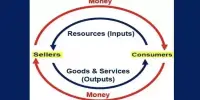Bridging traditional economics and econophysics entails combining insights, methodologies, and concepts from both disciplines in order to gain a more comprehensive understanding of complex economic systems. Traditional economics focuses on human behavior, market dynamics, and policy analysis, whereas econophysics uses physics tools and concepts to study financial and economic systems as complex, adaptive systems.
How do asset markets work? Which stocks behave similarly? Economists, physicists, and mathematicians work hard to paint a picture, but they must also learn about what is going on outside their field. A new piece of paper is now constructing a bridge.
The Complexity Science Hub researchers highlight the connecting elements between traditional financial market research and econophysics in a new study. “We want to create an overview of the models that exist in financial economics as well as those that researchers in physics and mathematics have developed so that everybody can benefit from it,” explains Matthias Raddant of the Complexity Science Hub and the University for Continuing Education Krems.
Scientists in both fields attempt to categorize and even predict how the market will behave. They want to build a large-scale correlation matrix that describes the relationship of one stock to all other stocks.
“Progress, however, is often barely noticed, if at all, by researchers in other disciplines. Researchers in finance hardly know that physicists are researching similar topics and just call it something different. That’s why we want to build a bridge,” says Raddant.
Progress, however, is often barely noticed, if at all, by researchers in other disciplines. Researchers in finance hardly know that physicists are researching similar topics and just call it something different. That’s why we want to build a bridge.
Matthias Raddant
WHAT ARE THE DIFFERENCES?
Experts in the traditional financial markets field are very concerned with accurately describing how volatile stocks are statistically. However, their fine-grained models no longer work adequately when the data set becomes too large and includes tens of thousands of stocks.
Physicists, on the other hand, excel at handling large amounts of data. “The more data I have, the nicer it is because then I can see certain regularities better,” Raddant explains. They use correlations as well, but they model financial markets as evolving complex networks. These networks describe dependencies that can reveal asset comovement, or which stocks behave similarly and thus group together. However, physicists and mathematicians may be unaware of what insights already exist in the finance literature and what factors must be taken into account.

DIFFERENT LANGUAGE
Raddant and his co-author, CSH external faculty member Tiziana Di Matteo of King’s College London, note in their study that the mechanical parts that go into these models are frequently similar, but their language is not. On the one hand, finance researchers seek to identify the characteristics that link companies. On the other hand, physicists and mathematicians are attempting to create order from a large number of time series of stock prices where certain regularities occur. “What physicists and mathematicians call regularities, economists call properties of companies, for example,” Raddant explains.
AVOIDING RESEARCH THAT GETS LOST
“Through this study, we hope to sensitize young scientists, particularly those working on an interdisciplinary basis in financial markets, to the connecting elements between the disciplines,” says Raddant. So that researchers who are not from the financial economics field understand the terminology and the key research questions that must be addressed. Otherwise, there is a risk of producing research that is of no interest to anyone interested in finance or financial economics.
On the other hand, scientists from traditional financial markets disciplines must understand how to describe large data sets and statistical regularities using methods from physics and network science.
















